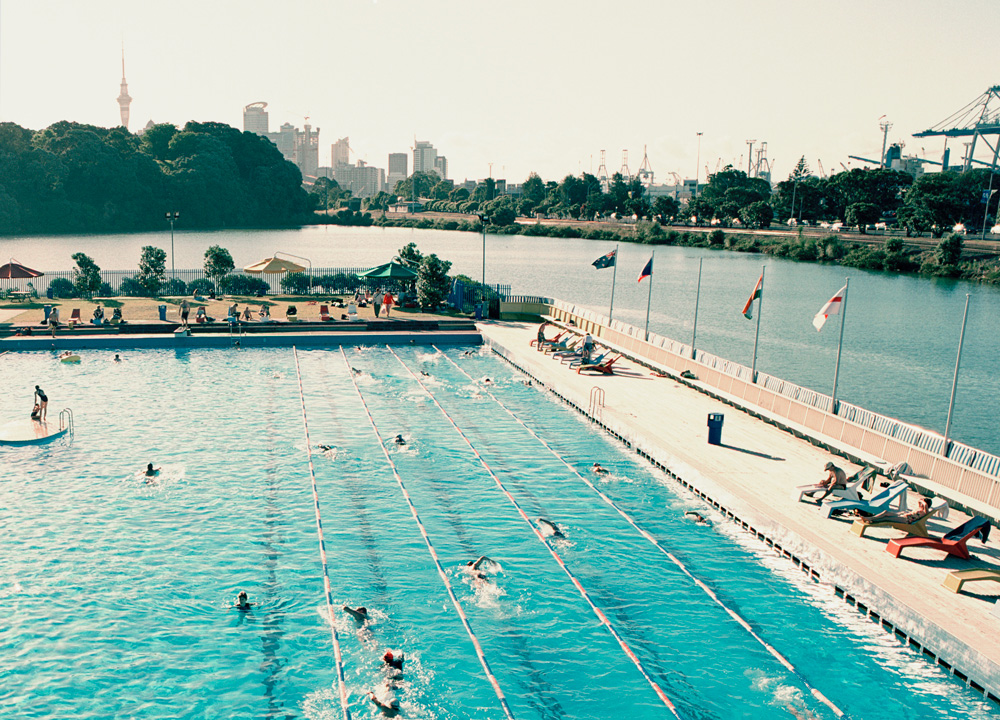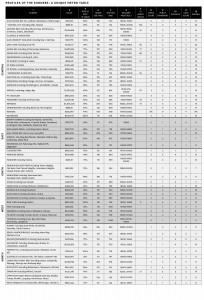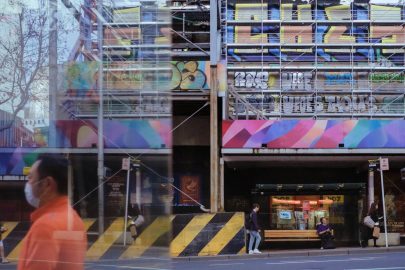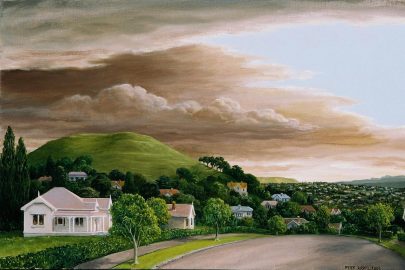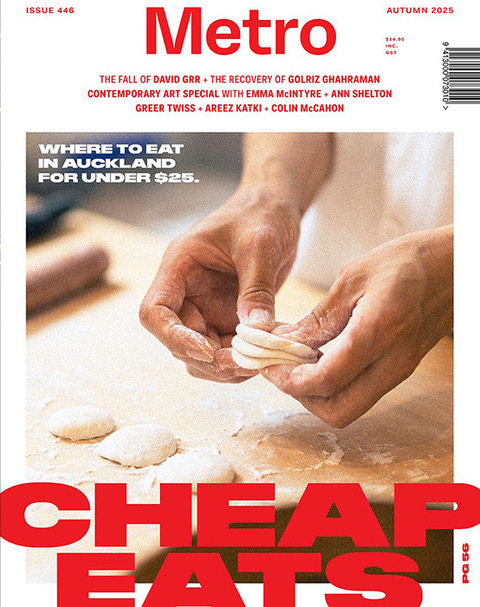Oct 30, 2014 Property
Mangere Bridge is “the new Ponsonby”. Did you see that headline? What does it mean? Has Mangere Bridge acquired a main street clogged with cars, a bust-ling nightlife, a horde of new designer boutiques? Is Sally Ridge holed up in some posh cafe while Matthew Ridge rides his little bicycle all over the pavements and Bill Ralston saunters along with his dogs?
Not quite. Mangere Bridge has Ambury Farm Park, where you can take the kids to interact with farm animals and picnic in rural beauty. It has a beach, a coastline and an old bridge, all perfect for meandering walks, bike rides and fishing. One of the city’s most outstanding primary schools, improving public transport services and a thriving little village complete with the lovely Ruby Red cafe. It’s even got its own volcano.
It’s also got house prices going through the roof. Up 114 per cent in the past 10 years; 17 per cent of that in the past year alone. (For all these figures and more, see our unique table below.) In the entire city, no other suburb has had a steeper rise in property values over the past 10 years.
And yet, while that means a lot of the homes in Mangere Bridge are already out of reach for many would-be first-home owners, the suburb is still one of the more affordable in Auckland. The average house price there is now $654,889 — eye-watering compared to the recent past, but nowhere close to inner-city prices.
Is Mangere Bridge the new Ponsonby? Fast-rising house prices and an influx of the homeowners who are driving up those prices may tempt you to think so. But still, the answer is no. The delights of Mangere Bridge are intrinsic to the place: it’s a seaside community with a commute.
Rising house prices will make the village more cosmopolitan, so there’ll be more cafes and — who knows — one day maybe even a boutique cinema. Subdivision will become more common and there will be, for a while at least, more cars on the streets. Public transport will probably continue to improve.
Yet Mangere Bridge will stay a seaside community, not the epicentre of some inner-city experience but a delightful suburb, cherished by the people who live there and not much visited by anyone else.
There’s a great secret in Auckland, known to most of us who live here but largely overlooked by everyone else: we live in the suburbs. And to a very large extent we define ourselves in relation to the suburb we live in. We are the people of Devonport and St Heliers, Northcote and Swanson, Remuera and Otara and Albany and Grey Lynn.
The delights of Mangere Bridge are intrinsic to the place: it’s a seaside community with a commute.
And there is also something quite special about so many of Auckland’s suburbs: they give us the sense of living on the cusp of town and country. It’s because so many of them are so close to beaches and the sea; and because of the volcanoes and the parks and the avenues of trees; and because of the weather. Mangere Bridge, like Browns Bay and French Bay and Mission Bay and Bucklands Beach, is a place where it is not hard to tell yourself: “I’m at home… and I’m on holiday.”
Mangere Bridge. Great place to live. It’s still on our list for middle-income earners, but it’s nothing like Ponsonby, except in this: it is getting harder to buy into by the nanosecond.
Ponsonby itself, by the way, has also experienced rocket-fuelled growth: an average home there now will cost you almost $1.3 million, which is up 90 per cent over the past 10 years — although prices rose only five per cent last year, so there’s possibly some sanity returning to that neck of the woods.
Four big trends in Auckland housing – and how to make them work for you
1. Move One Suburb Out
The spread of urban culture
As Ponsonby and Grey Lynn got fashionable, Kingsland property values started to climb. As Pt Chevalier values joined the upper-middle lists, Waterview and Te Atatu also started to climb. The rule of thumb is, if you fancy a particular suburb but can’t afford it, look just a little further out.
Keep stepping back: it’s what a lot of people are doing now, especially in the west.
There are two defining geographic determinants of house prices in Auckland. One is the rings around the central city, which are just like the rings in the trunk of a tree. The inner ring, the dress circle, runs from St Marys Bay, around Ponsonby to Mt Eden and Epsom, eastwards to Remuera, and up through Hobson and Parnell. Over the harbour, it includes Devonport, Takapuna and Northcote Pt. You step down in price brackets as you move back from that ring.
Keep stepping back: it’s what a lot of people are doing now, especially in the west. Western Springs, Owairaka and New Windsor, Avondale, New Lynn and Glen Eden are all the focus of some pretty intense house hunting. Mangere Bridge is on that list, of course, and we expect Glen Innes to the east and the more northern reaches of the East Coast Bays suburbs won’t be far behind.
Want a clue to what’s going on? Look for cafes. L’Oeuf in Owairaka is a gem. You might think it’s a little piece of Ponsonby stranded in a suburban block of shops, but it’s not stranded at all: that place is a sure sign a mixed and engaging community culture is developing in the area.
The other geographic determinant is the coastline: you pay a steep premium along the eastern suburbs from Orakei to St Heliers, along the inner harbour coasts from Herne Bay to Westmere and Northcote Pt to Birkenhead, and up the east coast from Devonport to Browns Bay. Again, on the whole you step down in price brackets as you move inland.
But you can stay on the coastline and still step down in price if you move away from those premium stretches. Beach Haven is far cheaper than Northcote Pt, while Greenhithe is one of many communities on the upper Waitemata Harbour where it’s still possible to buy on the coast without winning Lotto.
Over on the Manukau Harbour, Mangere Bridge is one of several relatively affordable coastal suburbs — others include Blockhouse Bay, Hillsborough and Onehunga. And the vast inlet of the Tamaki Estuary boasts some really great, as yet largely undeveloped coastal areas, including Panmure, East Tamaki and Edgewater. Drive around. Go down the odd little streets. You’ll find some surprising delights.
2. Get In First
The new brownfields suburbs
Stonefields is a model suburb for 6500 people in the old quarry at the base of Mt Wellington. There’s a school, shops, parklands including a wetland area, new public transport options and pedestrian-friendly urban design. When it’s finished, there will be 2500 homes, priced roughly in the middle of the market.
And it’s far from alone. Many new housing projects are under way or planned within the established urban areas of Auckland, including Hobsonville Pt on the upper harbour, which is a council showcase for modern “density done well” housing, and Three Kings, where Fletchers is seeking consent to build a large new subdivision on the site of the old Three Kings quarry.
While buying a home in an existing suburb — and therefore in an established community — has some obvious advantages, so too does becoming a part of something new.
Take the Three Kings project, which will include new parks and playing fields and give a big bump to public transport options. There’s some legitimate local concern over the fate of the volcano that was quarried (to what extent should its slopes be restored?), but it’s hard to believe the issue can’t be resolved well.
The council’s commitment to making new suburbs work is strong, because it is committed in its long-term planning to “density done well”.
This site has the potential for a very large number of modern, warm and dry homes — including many in the “affordable” category — complete with amenities, on a site quite close to the city centre. It’s exactly how Auckland should develop, and the people who live there are likely to benefit from both the council and the developers doing their best to make it work extremely well.
Our advice: look out for developments like these. The council’s commitment to making them work is strong, because it is committed in its long-term planning to “density done well”, and it wants that to become understood and accepted. It wants to be able to say, “Look, here’s the evidence we can fit more people into the urban landscape and make it better for everyone.” Many of the developers themselves share this vision and want to create vibrant communities within easy striking distance of the central city.
A different and much larger controversy attaches to developments in East Tamaki and Glen Innes, where the government, council and private developers are all involved in reinventing the old state housing areas. What’s being lost, say many locals, is the sense of community — the very thing that makes it most worth living in a place. What’s being gained, says Housing New Zealand, is the chance to create new communities living in better-built homes that are better matched to their needs. It’s been a bitter debate, and it’s far from over.
3. Move To The Country
The new greenfields townships
Slightly more town than country? If that’s you, Auckland is still the place to be. Whichever direction you travel away from the city centre, when you get to the edge of the urban area you’ll find new suburbs and townships under construction. They’re not as good for the environment as developments occurring inside the existing city limits, but they’re happening anyway.
They’re not as good for the environment as developments occurring inside the existing city limits, but they’re happening anyway.
Pokeno, 45 minutes down the Southern Motorway, is experiencing a major building boom on the back of a giant new Chinese milk powder plant. Out east, you’ll find the new town of Ormiston, formerly known as Flat Bush (there’s an ongoing debate about the most appropriate name), where the senior college is now in its fourth year and the population is growing fast. And in the north, two major new developments are well under way: Millwater Estate, near Silverdale, and Long Bay, immediately to the north of Torbay.
It’s farmland turned into town: in all these areas housing is cheaper than it is closer to the city, and the developers are conscious of the need to develop township amenities. The Todd Group, which did Stonefields, is behind the Long Bay project and has a pretty strong record in this regard. But there is a downside: it’s a long commute, and a long way from the restaurants, museums, galleries, shops, shows, waterfront events and other attractions of the cosmopolitan centre of the city.
It’s always easier for people living in or near the inner city to escape to the country than it is for people who live on the outskirts to drag themselves into the centre.
4. Move Right Into The City
The apartments boom
Twenty years ago, there were 1500 people officially living in downtown Auckland. Now, there are more than 25,000, and over the next 20 years that number is expected to double. Apartments are on sale all over the inner city. Some 200 more will be added with a new 48-storey tower, slightly taller than the Vero Centre, which has just been announced for Commerce St. The council’s Civic Building at the bottom of Greys Ave could be converted to apartments. And if you go up the Sky Tower and take a careful look down onto the rooftops, it’s obvious a great many downtown buildings — far more than the ones you expect — now have people living in them.
In theory, the era of shoebox apartments is over, and it’s certainly true that many property developers and their architects have been very keen in recent years to prove that is so. Good choices abound. But if you’re keen on living in the city and want to buy something off the plans, it’s still important to make sure you understand clearly what you’re getting into. The council has not stamped out bad developments yet.
It’s still important to make sure you understand clearly what you’re getting into. The council has not stamped out bad developments yet.
A little further out, apartment blocks are starting to rise along the Grey Lynn/Arch Hill stretches of Great North Rd. In 10-15 years’ time, parts of this wide, sunny, west-facing ridge are likely to have been transformed: there’ll be narrower carriageways for cars, dedicated bicycle lanes, broad pedestrian areas with cafes and shops, and a lively street life. A cinema and some off-street shopping developments are already moving through the planning process. All of this will be made viable by apartment blocks that put many more people into the area.
It will be similar at the mouth of the Orakei Basin, where a very big development edges towards realisation. Also on Union St to the west of Nelson St, where apartment living for “mature” people is under construction. And, perhaps most exciting of all, down in the Wynyard Quarter: the innovative and very appealing streetscaping already completed there makes a strong statement about the quality of developments to come.
All four locations have the potential to provide a big, mixed range of apartment homes with spectacular views, in the midst of busy, engaging, urban lifestyle opportunities.
In Newmarket, the expansion of the University of Auckland onto the old Lion Breweries site will bring an explosion of people to the area, and that will mean more shops, more nightlife and — if they plan it well — such good public transport that people won’t feel the need to drive nearly so much. It will also mean many more apartments.
All of this is a challenge to Newmarket and the people who make decisions on its behalf. To date, that precinct has been the inner-city area of most spectacular failure: shoddy apartment blocks, a barren train station, not nearly as many good cafes, bars and restaurants as you would expect, the sabotage of a premium shopping precinct (Nuffield St) by making it double as a bus terminal…
Newmarket, beautifully sited between the Domain and Mt Eden, has enormous potential. Buy an apartment there now and you could be in at the start of something wonderful. Or not.
Auckland’s hottest suburbs
Check out our table below: it shows current average prices and the movement over the past 10 years. It also shows the size of house and section you can expect, the age of the housing stock and where most of the apartments are. And in a unique Metro listing, we also rate drive time to the city centre, the frequency of public transport and the quality of local schools and cafes.
We have used all of these measures to compile these lists: the best suburbs in Auckland, in our view, in four different price brackets.
Hoping to buy for around half a million
If you’re in the market with much less than $500,000, southside is where you’ll find the most choice, especially around Manurewa and Otara. But if your budget stretches to that half-million mark and perhaps a bit beyond, you should include West Auckland and the northwest in your search.
1. Swanson
There’s a lot to love about Swanson: the easy semi-rural feel, the access to beaches and points north, the young families and the sense of community that grows around them. On top of that, Swanson and the suburban reach across to Massey are tipped for major growth in the years ahead: a home here now will be a definite investment for the future.
2. New Lynn
New Lynn is an efficient transport hub, and that will grow significantly when the electric trains are introduced. The town centre gets livelier by the day, and on the slopes and in the valleys all around there are many charming streets, quite a number of which have sea and/or bush views.
3. Beach Haven
A new ferry service, a meandering coastline offering all sorts of delights and a growing sense of community make Beach Haven one of the hot new spots. Still pretty cheap, but we doubt it will stay that way.
4. Upper Harbour
It’s already a very pretty part of the city, and the expanded ferry services, the new Upper Harbour Highway and the council’s medium-term development plans — which suggest this region will fill up with people — make the entire upper harbour region an attractive prospect.
5. Panmure
There are eyesores wherever you look in Panmure, but that may not last forever. There’s a boom in house prices, the shopping centre has had a makeover and there are very big plans for the Pt England/East Tamaki flatlands. Got a good coastline ripe for the picking, that region, and some very good schools too.
A home under $650,000
1. Piha
It’s “cheap” because a lot of the houses are baches, but if you don’t mind that — or the commute — Piha and the other west coast beaches offer the most spectacular, deeply soul-enriching home life you can find in all of Auckland. But those are quite big “buts”.
2. Glen Innes
Glen Innes is near some good schools, it has good shops and (in Auckland terms) pretty good public transport. It’s also within very easy striking distance of the beaches: St Heliers, Kohimarama, Mission Bay. A range of housing options is on offer.
3. Waiheke
The island has a reputation for soaring house prices and becoming filled up with mansions, but the reality is its property values have moved only 40 per cent over the past 10 years — that’s the smallest growth anywhere except in the central city and Piha. Mind you, it was 12 per cent in the past year alone, so it may be an island boom has just got under way.
The median on Waiheke is $635,667, but the average dwelling size is quite small, which means if you buy one of those cute properties in the listings, it will be either a cheapish home or an expensive bach. The ferry is free with a SuperGold Card, but the fares quickly add up for commuters under age 65.
4. Titirangi
Auckland’s classic suburb in the bush is still remarkably underpriced, and with a relatively modest (for Auckland) 75 per cent rise over 10 years, that’s not showing any sign of changing. Bush life doesn’t come much better than this, especially if you can find a good architecturally designed home. Spectacular views are on offer from the heights.
5. Mangere Bridge
See main story. Mangere Bridge is a lovely seaside village that’s also pretty close to the central city, and it’s in the midst (we see no sign of it slowing) of a house price boom.
A million-dollar home
1. Meadowbank
It’s cheaper than Remuera and there are far fewer mansions, but Meadowbank is only five minutes further up the road and thus enjoys most of the advantages of Remuera itself. Many years ago, this magazine famously identified Gowing Drive, looping along the northern slope with its 1960s housing stock and sloping sections, as the quintessential “middle Auckland”. It’s towards the upper end now. Even refurbished state houses in the suburb sell for around a million dollars.
2. Belmont
It’s pretty pricey to the south in Devonport and to the north in much of Takapuna, but between them in Belmont and Bayswater, relatively speaking, there are bargains to be found. It’s the one-suburb-back principle, and yet you still get most of the attractions of living on the Devonport peninsula.
3. Pt Chevalier
With a median value almost at $1 million, Pt Chevalier is overpriced: the houses are mostly small and the suburb doesn’t have much of a village. But there’s a beautiful re-sanded beach, a terrific park, all the afternoon sun you could want, a quick run into the central city and (once the Waterview tunnel and interchange are finished) motorway access both to the airport and to points south. Western Springs College is the best-performing decile 8 co-ed state school in the country, and the feeder schools are good too.
4. Grey Lynn
The villas are draughty, but that seems hardly to have dimmed the appeal at all. If you’re looking for a home with a view of the upper harbour and good access to parks, public transport, a thousand cafes and bars and the central city, Grey Lynn is for you. It’s Ponsonby with bigger sections and slightly cheaper prices.
5. Eastern Bays
Ah yes, to live in the embrace of Rangitoto. Nothing speaks of the quality of life in Auckland quite like Tamaki Drive — and who knows, one day there may even be trams (or ferries, as we have written before) to enhance the experience even more. Don’t wait for that, though: if it does happen, it won’t be anytime soon.
A home for well over a million
Below we have listed the suburbs with a median price over $1.25 million, along with the house price per square metre.
Ponsonby: $9050
Herne Bay/St Marys Bay/Westmere: $8170
Devonport: $8110
Mt Eden/Epsom: $6920
Parnell: $6884
Remuera: $5754
On median values, the most expensive properties are in Parnell and Herne Bay, although the biggest homes are in Remuera. Homes there are 70 per cent larger than in Ponsonby and the sections they sit on are 108 per cent larger — yet they cost only 8.5 per cent more. To put that another way, the crammed-together villas of Ponsonby cost almost as much as the graciously fenced-off mansions of Remuera.
The best suburb in Auckland
Is it possible to go past Parnell? Beautiful homes on leafy streets, excellent schools, lots of amenities including public transport (it’s even on the Inner Link bus route), a shopping village whose vibrancy is proudly asserted, close to the central city yet fully insulated from it. Parnell has also had relatively low property price rises: it’s not at all cheap, but nor is it out of control.
With the Domain on one side and the Rose Gardens and Hobson Bay on the other, it has far more than any suburb could claim as its share of parklands. Lucky them. And the crowning glory? Well, what about Judges Bay and those refurbished Parnell Baths, eh? Auckland at its very best.
Read more:
Six Alternatives to Buying a House in the Auckland Suburbs
Buying a House at Auction: 10 Secrets to Success
Finding Investment Property That Pays
Profiles of the Suburbs: A Unique Metro Table
Click on table above to see a full-sized version.
Notes to the Table
1 Suburb
With help from CoreLogic, we grouped adjacent suburbs that we considered broadly equivalent from a home-hunter’s point of view.
*Central city and Newmarket property data relates only to apartments.
2 Value
Median (midpoint) house and apartment values were derived using a smart measure by CoreLogic. An E-Valuer gives an instant estimate of the current market value of a property based on recent, nearby comparable sales. Each sale is weighted based on its similarity. Using E-Valuer, CoreLogic calculated the median value of all houses or apartments in each of our suburb groups. We chose this measure over median sales because it reflects robust estimates for every single property, rather than only those that happened to have sold in a given period.
3 Rise in past 10 years
The percentage change in median value over the past decade. Source: CoreLogic.
4/5 House & section size
Section size not given for apartments. Source: CoreLogic
6 Decades most built
The periods in which at least 15 per cent of homes were built. Source: CoreLogic.
7 Percent apartments
Apartment data is included for suburbs with at least 10 per cent apartments. Source: CoreLogic
8 Drive score
Drive times to the central city from different parts of a suburb will vary, and not all rush-hour commutes end in or go through the central city.
5 = 10 minutes or less;
1 = longer than 35 minutes.
9 Public transport score
The frequency of weekday service, ranked from 1 (lowest) to 5 (highest). In the case of multiple suburb groupings, the highest score is given. Source: Auckland Transport Business Intelligence — Jared Smith.
*Waiheke buses are not frequent, but are well fitted to ferry timetable.
10 Schools
Scores according to Metro’s unique ranking of high schools (state and integrated), on a decile-adjusted calculation of UE pass rates (The Best Schools in Auckland 2014).
11 Cafes
Ranked by number and quality, on a scale of 1-5.
(For the 20143 list of Auckland’s top cafes, see metroeats.co.nz.)
12 Overall
A score that combines 8-11.
About CoreLogic: CoreLogic is a property information, analytics and services provider that helps clients to identify and manage growth opportunities, improve performance and mitigate risk. corelogic.co.nz
This story was first published in the October 2014 issue of Metro.

